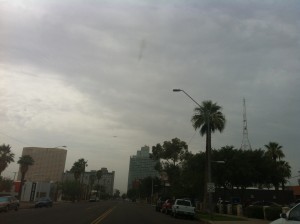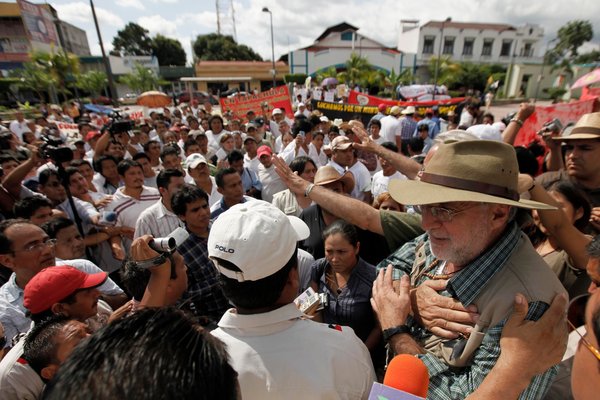 On a cloudy day with cool-for-Phoenix temperatures in the low 90s, a small group clustered around the Arizona Department of Health Services entrance, reporters holding mics and cameras up to catch the words of local activists giving press conference follow-up comments amid the noise of street and air traffic. The faces and backgrounds were as diverse as the groups they represented which included churches, labor organizations and activists for peace. The real event that would bring them all together would take place that evening, when the Caravan for Peace tour arrived downtown, but they were here to explain why they brought the tour to Arizona.
On a cloudy day with cool-for-Phoenix temperatures in the low 90s, a small group clustered around the Arizona Department of Health Services entrance, reporters holding mics and cameras up to catch the words of local activists giving press conference follow-up comments amid the noise of street and air traffic. The faces and backgrounds were as diverse as the groups they represented which included churches, labor organizations and activists for peace. The real event that would bring them all together would take place that evening, when the Caravan for Peace tour arrived downtown, but they were here to explain why they brought the tour to Arizona.
“We have members who have family members living in Mexico,” said Rev. Liona Rowe of Shadow Rock United Church of Christ. “I can’t say that there’s anyone particularly in the congregation who’s been directly impacted by that and yet all of us are impacted, the way our communities are so dysfunctional can certainly be traced back to what’s going on.”
And it’s communities like Shadow Rock that did the planning for the events and are also providing hospitality for the Caravan tour as it travels.
“We set up a planning committee and we’re a coalition of many groups,” said Mary Hope Lee of the Phoenix Caravan for Peace Coalition. “You find partners who are willing to sign on and reach out to the community for resources and we were very fortunate to acquire everything we needed to make this happen.”
The Caravan for Peace tour is a cross country, cross border event that’s scheduled to last a month as the participants wind from Tijuana to Washington, D.C., stopping at major cities along the way to share stories of how drug violence has impacted their lives. The tour also uses social media like Twitter and Facebook to stems from the work of poet-turned-activist Javier Sicilia. Sicilia, who lost his own son to the violence and whose efforts to raise awareness about the victims of drug violence and protest policies on their behalf in Mexico have already brought him attention at national and international levels. Now he’s bringing his message to the United States, and bringing others with them to share their stories too.
And the stories are powerful. Along with the thousands of people killed for years now, there are also cities turned into battlegrounds and families shattered by lost family members – many of whom go years search for answers.
A schedule conflict prevented me from being able to attend the evening events and unfortunately the fast moving tour is already on the move, headed next to Tucson and then New Mexico. But I’ll be eagerly reading coverage from my Phoenix colleagues if you’re on the route, you have the chance to hear these incredible stories in person over the weeks to come.

Leave a Reply